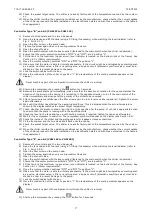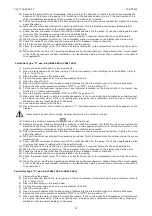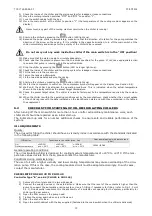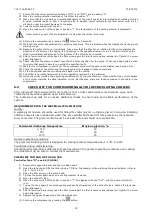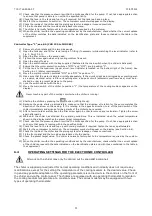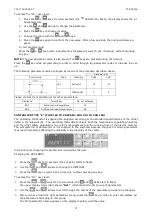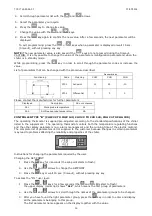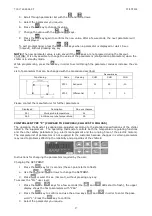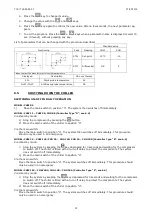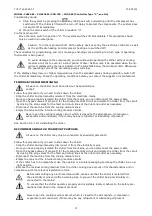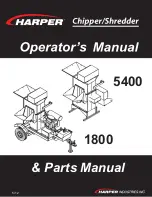
710.1760.00.04-05
22/05/2014
14
♦
A bypass system with suitable valves upstream and downstream of the chiller. This is intended to
allow use of the consumer circuit if you have to remove the chiller from the circuit, switch it off or
use it in different ways at the same time
.
♦
A pipeline system with integrated filter near the chiller to protect the pump against solid matter
and avoid deposits on the heat exchangers. The recommended mesh width for the chillers is 25
µ
with a maximum pressure loss at the filter of 1 bar
.
The use of a filter with a mesh width of 60
µ
is
particularly suitable for chillers of the CHO series if they are fitted with a gear pump, so as to
avoid unusual wear of the component.
♦
In the models without flow monitoring, we suggest that you should install such a component if
the system exhibits losses or very high cooling medium consumption due to evaporation or inter-
vention by the operator. A further reason may be triggering of the solenoid valve to shut down
the system. The flow meter may trigger an alarm and enable immediate operator intervention.
♦
On no account may the total pressure loss of the system exceed a value above that of the pump
performance.
♦
Another option for directly filling the tank involves attaching a T-fitting to the cooling medium
outlet fitting in order to connect the cooling medium circuit with a supply pipe. This is used to fill
the chiller. We also recommend connecting a valve to the supply pipe in order to stop the flow
when the tank is full or to restart the flow as soon as a top-up is necessary.
A
Male-male fitting
B
From the supply line
C
To the consumer cooling circuit
D
T-fitting
E
Connecting piece to cooling
medium outlet
Fig.1
CONNECTION TO THE ELECTRICITY MAINS
The properties of the electricity mains (size, protection system, earth connection) must comply with the
legislation applying to the electrical properties of the chiller in the country in which it is installed.
The general regulations pertaining to installation are listed below.
The electrical installation may only be carried out by qualified personnel!
The mains connection should be established with a rubber-sheathed cable connected to a TN-C system
with direct earthing.
230 V version (1 phase):
Connection with a single-phase, three-wire system (1/N/PE AC). The phase conductor and the neutral
conductor must be connected directly to the main switch of the chiller.
The protective earth conductor must be connected to the earthing point of the chiller.
400 V version (3 phase):
Connection with a three-phase, four-wire system (3/PEN AC). The three-phase conductor must be con-
nected directly to the main switch of the chiller. No neutral conductor is used. The PEN must be connect-
ed to the earthing point of the chiller.
If different mains voltages and frequencies are available, the country-specific features must be observed.
Make sure that the mains voltage and the frequency match the data on the identification plate of the
chiller and agree with those in the table in the supplement and that the permitted values are not exceed-
ed. Check the mains for correct values and test the function of the earthing and protection systems.
Summary of Contents for CHG 08
Page 40: ...710 1760 00 04 05 22 05 2014 40 CHW 20 25 CHO 10 cST CHG 20 25 5 EN 60204 EN 378 2...
Page 41: ...710 1760 00 04 05 22 05 2014 41 HFC CE 842 2006 3 3 1 3 2 C CND EVA HP LP...
Page 42: ...710 1760 00 04 05 22 05 2014 42 MHP MLP PV R V a 2 5 b VE 2 5 MOP IAF 3 3 MF P...
Page 43: ...710 1760 00 04 05 22 05 2014 43 BP BPM CAA EV 1 1 VNR FL LVE RA TD VNR EV 1 2 3...
Page 44: ...710 1760 00 04 05 22 05 2014 44 1 2 3 4 5 6 7 3 4 ALR...
Page 65: ...710 1760 00 04 05 22 05 2014 65 CHW 682 CHW 3652 CHG 225 CHG 365 6 4 1 2 0 0 5 2 1...
Page 67: ...710 1760 00 04 05 22 05 2014 67 5 6 8 9 10 3 20 15...

















